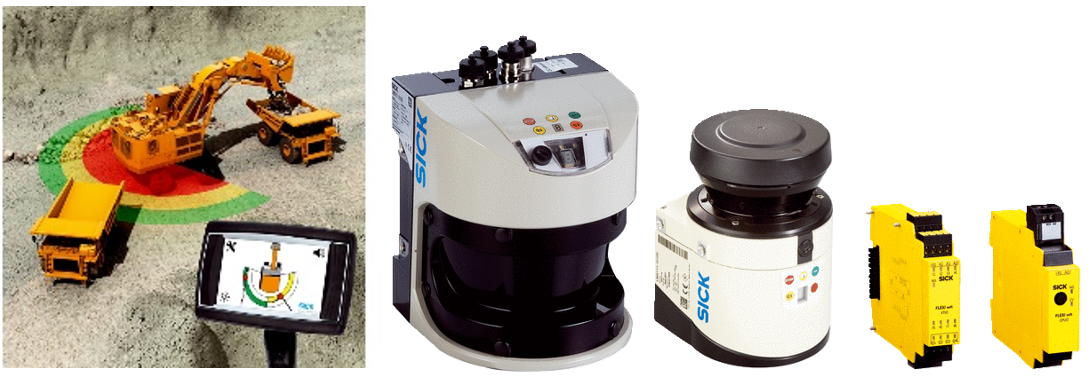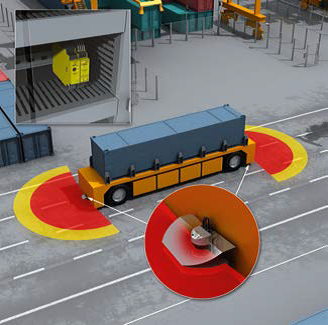
SICK Outdoor Safety LiDAR

Adding a level of safety to outdoor mobile robots
With the recent adoption of unmanned vehicles, robots, and other means of automation, collision avoidance has transformed from a predominantly human responsibility to a fully automated function.
LiDAR (light detection and ranging) has been in use since the 1960s. LiDAR measures the distance from an object by illuminating the object with a pulsed laser and then measuring the reflected pulses with a sensor. The difference in wavelength and the return time is then used to generate a 2D or 3D representation of the object and calculate the distance. The recorded data can be processed internally or made available for external processing.
Today, LiDAR technology is used in many indoor robotics and automation applications, including collision avoidance. Traditional LiDAR collision avoidance systems are essentially standalone devices that use laser measurement sensors, single beams, or light curtains to measure distances. These systems lacked a self-testing capability and did not provide the high degree of diagnostic coverage and signal pre-processing that is essential for a complete collision avoidance system.
For indoor applications, safety certified lasers like the S300 can be integrated into mobile platforms to provide a safety control loop that runs in parallel with the robot’s navigation software. This creates a redundant safety system.
Outdoor applications, however, have been a challenge. Laser-only systems do not always perform well in outdoor environments and cannot be trusted to provide the same safety and reliability as indoor systems.
Factors that decrease the reliability of laser safety systems in outdoor applications include bright sunlight, rain, snow, variable temperatures, and electrical noise. These can adversely affect the laser’s ability to accurately read the reflected pulses and can cause the system to malfunction or lose its navigation capabilities.
To address these shortcomings, SICK has developed AOS Prime (Advanced Object Detection System).
AOS Prime is a self-testing system with diagnostic capabilities. AOS is used in monitoring applications that require high operational reliability, and for which a standalone laser scanner would be insufficient. In addition to optical sensor testing, the sensors’ response time and output signals are continuously tested during operation. AOS fills the gap in outdoor areas where laser scanners alone are not enough and high system reliability must be ensured.
Key Features
- Variable monitoring fields to avoid collisions
- Industry-proven 2D LiDAR sensors with enhanced diagnostics for outdoor applications
- Scanning ranges up to 35 m on dark objects
- Automatic self-test cycles for the entire system and enhanced system diagnostics
- Safe monitoring of the correct switching behavior and laser scanner connection cable
System Components
AOS’s main components are the LMS Outdoor Laser Scanner and the Flexi Soft central system control.

All laser scanners are linked to the control via switching signals. The controller sends cyclic commands to the scanners, all of which must respond within a predefined time window.
Applications
 |
Monitoring airplane boarding bridge movement To help passengers board an airplane, a passenger boarding bridge must be maneuvered to a precise location using a drive unit. The AOS Prime object detection system monitors an area around the drive unit, and automatically slows or stops the drive unit’s movement when a warning field is violated. These areas are freely definable, and AOS Prime can monitor several fields simultaneously. |
 |
Avoiding collisions between ship cranes and other structures Mounting AOS on a gantry crane provides a safe and reliable method of detecting ship superstructures, such as radar systems. By analyzing the warning and stopping fields of various 2D LiDAR sensors, AOS prevents collisions between cranes, booms, and other objects. The safety controller and integrated control software monitor the system functions and ensure reliable operation. |
 |
Collision avoidance AOS Prime is a reliable solution for preventing gantry crane collisions. This object detection system consists of a 2D LiDAR sensor and a safety controller. The 2D LiDAR sensor helps avoid collisions between the crane and other objects, and helps the crane operator monitor the route to be traveled. With wide ranges and variable monitoring fields that allow the operator to adjust the length and width, AOS Prime is a reliable and versatile solution. |
 |
Monitoring automated guided vehicles (AGVs) AOS Prime prevents collisions between AGVs and other objects in container yards. When objects are detected in the monitored areas, the AGV’s movement is automatically slowed or stopped. |
 |
Access control at automated stacking cranes (ASC) In container ports, interactions between man and machine can be dangerous. AOS makes those interactions safer. For example, truck drivers and straddle carrier operators deliver containers below an automated stacking crane. A 2D LiDAR sensor can enforce vehicle access (by positioning the sensor with a vertical monitoring area), and detect over-height objects (with a horizontal monitoring area). The Flexi Soft safety controller processes any signals and transmits them to the system controller. Cranes are automatically stopped to avoid collisions, and when the crane is already located within the transfer area, a stop signal warns other vehicles not to enter. The system can be expanded with RFID, GPS, and other types of sensors to enable vehicle identification when automated guided vehicles (AGVs) are in use. |
Disclaimer
Using AOS as a core of machine safety system can help achieve various safety performance levels. However, SICK does not classify AOS, on its own, as a “Safety System.” The actual safety performance level depends on many factors, including overall system design and total number of scanners (for instance, dual-channel scanners are more reliable).
Ultimately, the responsibility for safety rests with the integrator, who must verify the safety of their AOS implementation on the customer's machine. The implementation is also subject to the review of local safety authorities.
Contact us to learn more about SICK's AOS Prime safety system and how it can be used to improve the safety of your outdoor mobile robots.
